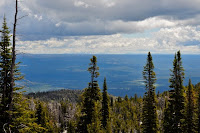
The roadways in Yellowstone National Park are laid out in roughly a figure eight. Today we decided to travel the top half of the "eight" and take in the sights of the northern part of the park. We've noticed a significant increase in car traffic in the park, which makes road construction extra time consuming.
Our first stop of the day, if you don't count road construction, was the Artist Paintpots area. This small thermal area features colorful basins that bubble and dance along a one-mile boardwalk loop.
And what are these visitors to the paintpots gawking at?
It's a mudpot! This seething pool of sulfuric acid, silica, clay and dash of water was fun to watch, but not so pleasant to smell. By the looks of the white splatters on the boardwalk, there are days when the mud really flies. Visitors, beware!
Nearly half a million years ago, the Yellowstone Caldera deposited a flood of hot lava. As the lava cooled it formed these columnar joints known as Sheepeater Cliff. Today, it's a great spot to enjoy a picnic lunch.
A busy turnout just south of Mammoth Hot Springs offers two noteworthy sights. Rustic Falls has a unique and interesting shape as it flows into Golden Gate Canyon.
Turn around from Rustic Falls and you see Golden Gate Canyon. The canyon walls take on their golden hue as a result of lichen on the rock. That precarious roadway is Yellowstone's Golden Gate Bridge. Not quite the same as the bridge we knew in San Francisco, but it's impressive, nonetheless.
Mammoth Hot Springs was interesting. Mostly, it was very crowded. We took in the views at part of the Upper Terraces. We left the lower portions for another day.
Off the beaten path a bit at Mammoth Hot Springs sits Orange Spring Mound. There are several vents in this monster mound. The mixture of water and bacteria deposits gave this side a shimmering, almost scary look.
On the back side of the mound, this happy little vent bubbled away, covering the mound in more shimmering water.
We were treated to several animal sightings on this trip. This is how you know a bear is nearby. It's a mob scene! We did see the bear wandering along the tree line some distance off the road. But, we had to keep our eyes on the stupid bystanders. Here, the park ranger was encouraging traffic to keep moving. So, we did. See the guy in the left side of the photo? He walked right out in front of our moving Jeep...with his children! Thankfully, nobody was hurt. And, the ranger gave him a tongue-lashing.
This trio of cow elk caused a minor "animal jam". So, we got a quick "drive by" shot.
The highlight of today's critter spotting came on the trail to Wraith Falls. We had to manuever our way through an animal jam caused by a bull elk grazing along the road. It just wasn't worth the fight to get a picture of that guy. We were ready for a stretch, so we decided to enjoy the one-mile round-trip hike to this 100-foot gently sloping cascade along Lupine Creek.
After a minute or so on the trail we were greeted by a bull elk. Isn't he beautiful?
Unlike the animal jam down the road, we had this guy to ourselves. And, he put on a magnificent show! He posed for some 80 pictures. (Aren't you glad we decided to just show you two?)
We left our gorgeous friend resting in the grass. Soon he was greeted by other camera-toting hikers. (See, he wasn't very far away!)
On the opposite end of the size scale, we spotted this little ground squirrel just up the path.
On the way back from the falls, we spotted this pair of marmots on guard in the woods.
A few steps later we saw what they were protecting. This is one of several babies with the pack. Before we got back to the Jeep we spotted an antelope, too. Unfortunately, he was too far away for a photo.
We wrapped up the northern Yellowstone loop with a trip over Dunraven Pass, at 8,859 feet. After that, our trip home was all downhill!






























































